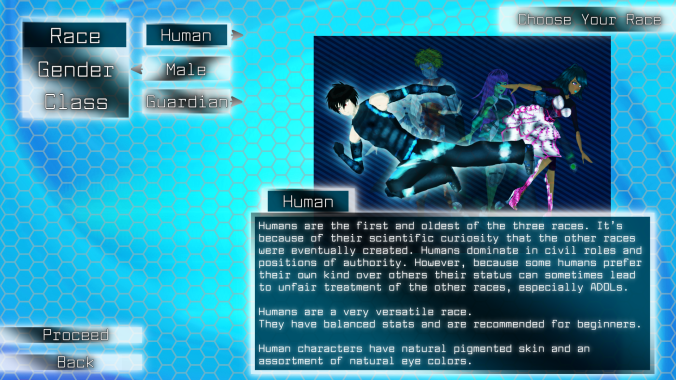I’m pretty proud of getting the GDD (game design document) finished.
It’s only about 88 pages long but the way I would describe the document is like it being an entire “blueprint” for the game. Put simply, I could literally give the GDD to another developer and they’d know exactly how to design the game in the way that I envisioned it (on a technical and gameplay level at least). Of course, they probably wouldn’t have the passion for the project like I do and they probably wouldn’t be able to nail the same exact “vibe” or “feel” that I would when designing BUT everything’s practically in that GDD.
So for this post, I decided to include a section of the GDD which talks about the basic game design concepts of the game:
Game Design Concepts
A Non-MMO, MMO Experience –
The main concept of Astraverse is to have a highly replayable multiplayer loot and level grind Role-Playing Game in a similar style and setting to Phantasy Star Online that can be fully experienced without an online or MMO server. A popular example of this would be most games in the Monster Hunter series. Almost all of the Monster Hunter games do not rely on MMO servers at all but they feel and play like MMO’s with highly replayable gameplay and a heavy emphasis on multiplayer co-op.
Character Creation –
The character creation should have enough depth to feel like a player’s character is a reflection of themselves or at least feel like their own unique and personal character. Just like in PSO, PSU, PSO2 and the spin-offs of said games, the character creation should be an immersive feature, not an afterthought.
Stages –
The stages in the game should be randomly generated enough to artificially expand the size of the game world and simulate the experience of exploring entire planets without the use of open-world gameplay. Phantasy Star Online’s randomly generated areas and the original Phantasy Star games’ planetary traveling systems and overworld are both excellent artificial world expanding features that can be easily combined to make a new system that’s simple but effective enough to gain this result.
Player-Generated Experiences –
The gameplay should make possible unique “player-generated” experiences/stories through harmonized gameplay systems. For example, a player losing all of his or her health shouldn’t be the end of a game experience. That user experience can be made more unique by giving players a more difficult and higher-stakes situation to deal with as a result of a player’s loss. Games like Dark Souls and Shovel Knight actually handles this quite well. Other examples of user-generated experiences is the moogle letter delivery system from Final Fantasy Crystal Chronicles and the open-ended quest system of Divinity Original Sin 2.
Single Player –
The single player campaign should have a uniquely captivating story that compliments the gameplay without taking away the focus from it. Also, single player mode should also be at least “hinted” at being connected with the multiplayer experience–for example, the story shouldn’t give the player a unique/exclusive position in the game world (like being the “hero” of the galaxy) but should instead make reference to the player’s traits that make him/her unique. A story character, for example, may even say things like “I know some other rookie Seekers like you” — in effect, making reference to the existence of other players playing Astraverse.
Immersive Game Setting –
The setting should be a science-fiction fantasy world without the existence of magic. Most of everything, including basic systems, should have some sort of explanation through the game world’s presentation and lore. An outstanding example of this can be found in Phantasy Star 2 in which a player’s saved data file is directly referenced within the game world as the player’s “memories” and are stored in a “data center” whenever a player saves his or her game.
Multiplayer Graphical User Interface –
Menus, shops and anything else that is displayed with the GUI should not hinder the experience of other players but should enhance it. Shops should be accessible by all players at once without the need of splitting the screen or forcing players to shop separately. Player hub information and menus should be restricted to parts of the screen that do not take away from the experience of other players during same-screen co-op.
Artstyle and Music –
The art style should feel like a mixture of the look and feel of Phantasy Star Online and Phantasy Star 4 with references to retro Science-fiction artwork and the hand painted or hand drawn nature of Vanillaware’s art style.
The music should sound a lot like Phantasy Star Online’s music but also blended with my own style of trip-hop music.
Link to one of my instrumental albums (as an example): https://lastbenevolence.bandcamp.com/album/pinakamaganda
I decided to throw that example link there at the end for those who were not familiar with the kind of music I created.
– LB


